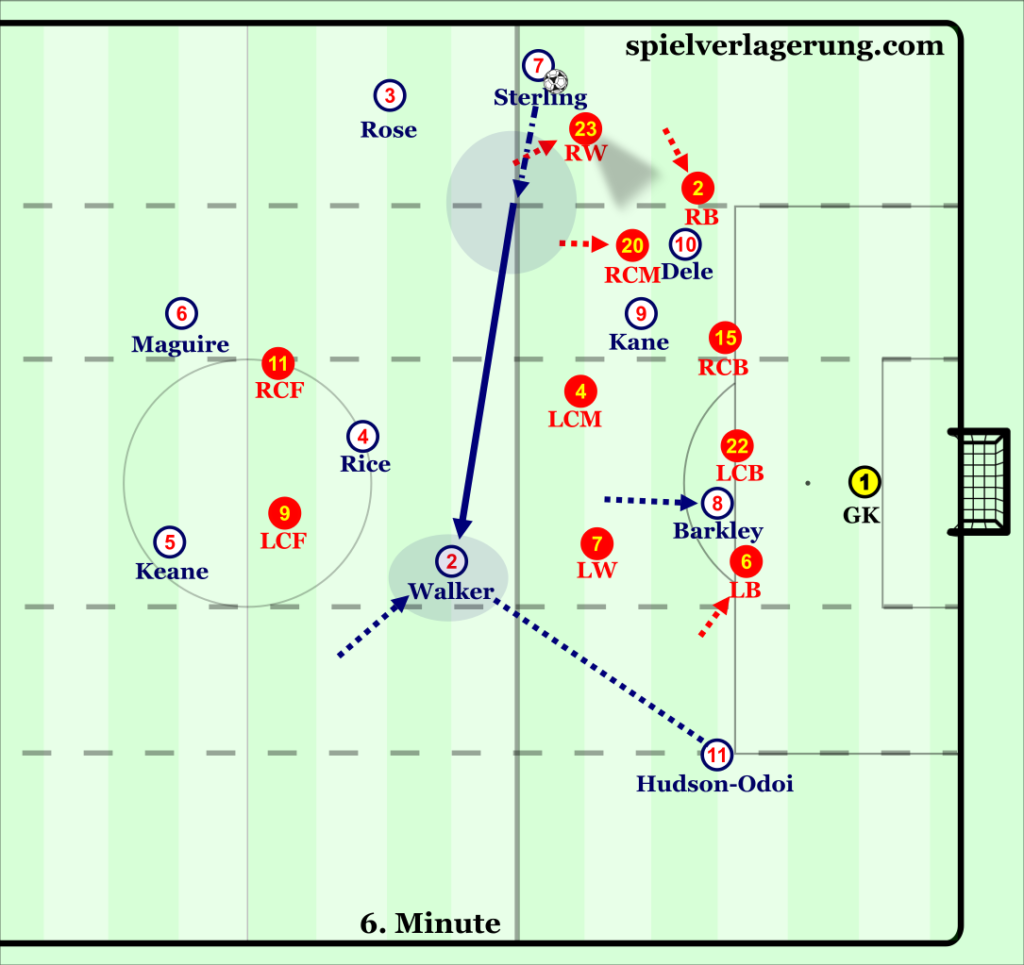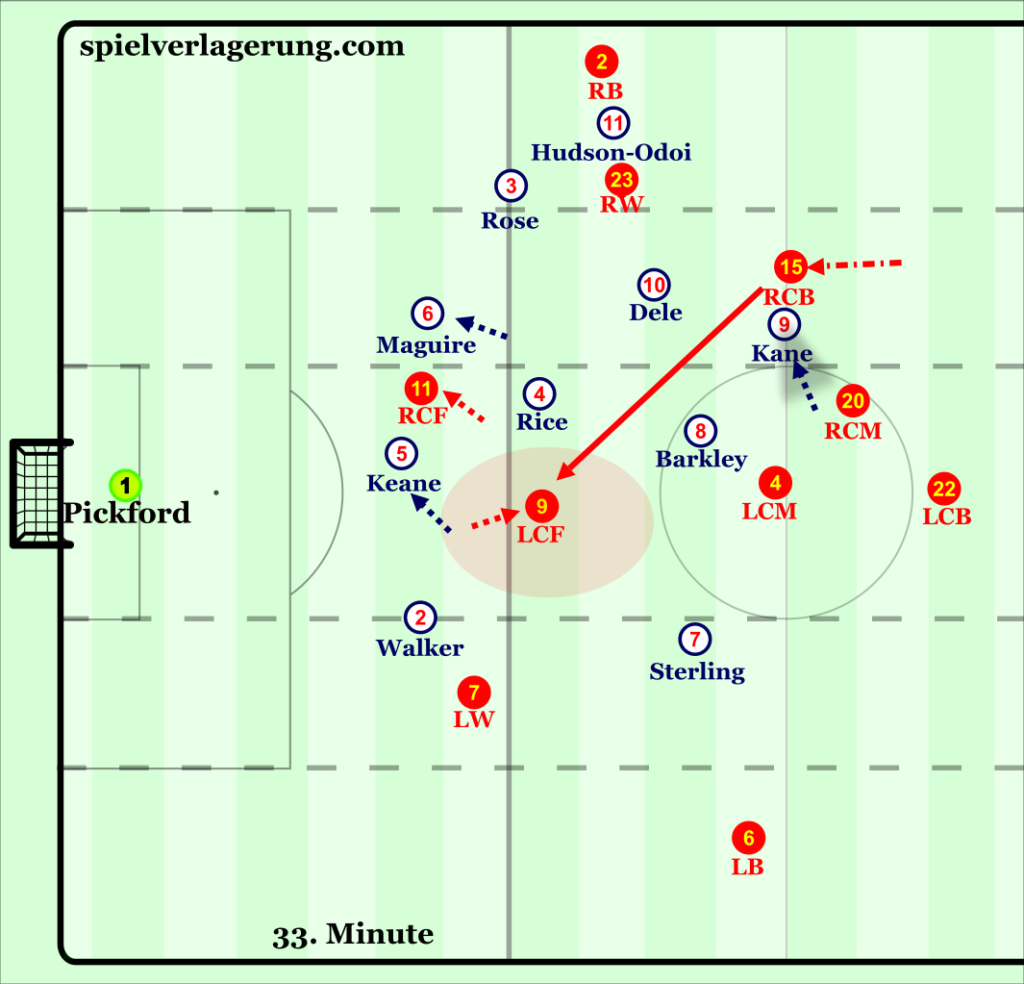England thrash Montenegro – dominant start of the ECQ campaign
Scoring 10 goals in the first 2 games, with convincing overall display, system flexibility, whilst using several newbies in the starting line-ups are all definite factors that makes these 2 wins even more impressive.
Line-ups
Southgate mixed the starting 11 with several changes in the line-up, but without changing the overall structure of the 4-3-3. Rose got to start on the left hand side behind Sterling, whilst as a result of Dier’s -and probably also Henderson’s slight -injury, Declan Rice started his first game at the defensive-midfielder position. It was also Callum Hudson-Odoi’s first start in the national team, which is especially interesting since he hasn’t started in a league game for Chelsea yet, probably raising several interesting questions about how english teams are managing their youngsters -it will be interesting to see if these kind of bold decisions from Southgate could eventually change this process or not.
Montenegro missed Jovetic, their star player at the CF position, whilst Savic was able to start at the back, adding them an extra quality in their deep 4-4-2 block. Missing Jovetic probably forced them to use an even more defensive approach, although lacking a clear strategy and effectivity to counter attack, England was able to control the space well on Montenegro’s half, resulting a huge domination of the ball, and the game’s dynamics as well.
Early dynamics
The basic aim for Montenegro was to control and slow down England’s wingers as much as possible, therefore their full-backs fundamentally positioned themselves narrower, to avoid getting exposed by the widely positioned wingers’ runs in behind-which basically became a very effective counter-movement to exploit the full-backs’ aggressive defending outwards, whilst trying to close down the wingers at the moment of (or before) their 1st touch. With the FBs being narrower Sterling and Hudson-Odoi had more spaces at the flanks to receive & turn & accelerate, although Montenegro’s wingers dropped even deeper -Marusic on their right side-, so it was often that Marusic closed down Sterling on the left hand side, whilst the FB was offering control behind him, decreasing and closing the space for Dele to get behind. On paper this gives a clear strategical advantage for the offensive winger, but with Montenegro’s deep and horizontally compact shape they were able to control England’s wide movements in the first 20 minutes.


England’s right-sided issues in defending
With both of Montenegro’s central-midfielders being deeper they were able to pull out England’s 2nd line, especially on Barkley’s side. As Vukcevic/LCM tended to drop and stay deeper in the left halfspace, it forced Barkley to stay a bit higher in order to have the optimal defensive access and distance to close Vukcevic/LCM down. This itself wouldn’t have been an issue, if the winger -Hudson-Odoi, then Sterling- behind Barkley had adjusted his defensive positioning to close more inside and deeper, but without this adjustment the space behind Barkley remained uncontrolled and wide open – in fact 8 of 9 Montenegro shots came from this side-, where Savic was able to find Vesovic/LW or Mugosa/LCF in between the lines after diagonal switches – the problem of closing down Savic from an optimal angle arose as well.

A possible idea for the defensive shifting: Dele to close the RCB, Kane to stay more central, that would allow Barkley to be deeper
Southgate adjustments, improving wide dynamics
Through the longer possession spells the continuous adjustments were clearly visible, especially on the left side. Rose and also Maguire became much more active and aggressive for their on ball actions: as Rose drove forward with the ball more, he was able to pull out the right-winger to open up more space for Sterling & Hudson-Odoi to receive and to have space for 1v1s against the right-back. Here also Dele’s positioning was fundamental to improve the wide dynamics: in the beginning he rarely moved wider -or if he did, not with the optimal timing to create separation- towards the wingers , therefore he was closed down by the right-back or the right-centreback more easily. As he noticed that, he started to occupy a much wider positioning and with the wingers staying up higher Montenegro had to change their defensive coverage, with mostly the RCM to cover towards Dele. These changes also manipulated the right-winger to stay a bit more inside, which opened up the direct passing lane from Maguire towards the left-winger, fastening up the speed of passing towards the wingers.


After equalizing from a free-kick there was an even more effective change: Sterling and Hudson-Odoi switched sides, which further improved England’s usage of the wide zones, and their overall circulation. From the left Hudson-Odoi had a better angle to make the 1v1s against the right-back -either cutting inside or towards the goal line-, whilst it formed a better connection between Walker-Sterling down the right hand side. Also, Montenegro had a little different defensive dynamics on their left due to Walker’s positioning: with often being deeper and inside he offered a shorter option whilst circulating the ball from the left to the right, and it also pulled out the left-winger from the 2nd line more, eventually opening up more space on the right for Sterling & Barkley to receive. As Dele on the left, Barkley also occupied better positions in between the lines to offer a better support for Sterling. This dynamics also had a key advantage: with Walker pulling out the left-winger and Barkley’s position to occupy the left-midfielder, the LB has been left without defensive support against Sterling, from where he could be manipulated to move a bit outwards, especially at situations close the goal. This is where Sterling’s signature move came into place: he often tends to make a body-feint towards the ball, to force the defender to make a step outwards, which is just enough to get him exposed with a run in behind – needless to stay, both the 4th and the 5th goal came from Sterling attacking the inner side of the full-back.


Future directions
In overall England’s application of the positional play principles is quite effective, and in fact, fluid & flexible. Against the Czech Republic, the wide dynamics based on more rotations between the FB-CM-W triangle, a movement that is often applied by Liverpool and Tottenham, whilst against Montenegro there was a bigger emphasis on holding the positions and playing from there, which is the basis of Manchester City’s approach. This kind of mixture in the positional play can not only give more options for the coach in creating a game’s strategy, but also offers easier in-game adjustments, if needed -not to mention the defensive aspect of this.

For several instances, they were able to invite Montenegro to press through circulating at the back -an essential positional play principle-, and exploit the generated spaces in behind the oppositional 2nd line, mostly on Walker’s side. Nevertheless this is definitely an area where they could improve -they had the same issue against Czech Republic in the first 15 minutes of the 2nd half-, to be able to manipulate the oppositional structure in a more conscious way and to find the generated free-man -the basic orientation is there, but the process to create access towards them is still not optimal yet. Although, the return of John Stones and Joe Gomez in the CB positions could add an extra quality in passing value -especially decisive against higher ranked teams-, not only in inviting the oppositional press, but also in being more aggressive for the on ball actions and the general decision making to control the possession from the back.

Keine Kommentare vorhanden Alle anzeigen